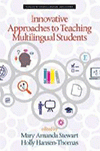
Innovative Approaches to Teaching Multilingual Students
Edited by:
Mary Amanda Stewart, Texas Woman’s University
Holly Hansen-Thomas, Texas Woman’s University
A volume in the series: Literacy, Language and Learning. Editor(s): Claudia Finkbeiner, Universitaet Kassel. Wen Ma, Le Moyne College.
Published 2023
The purpose of this book is to guide teachers to understand theory related to teaching multilingual students and put it into practice in their classrooms. Throughout each chapter, the authors uniquely bring together relevant theory regarding language (e.g. the multilingual turn, second language acquisition, translanguaging) literacy (e.g. reading comprehension, new literacy studies, multimodality), and culture (e.g. funds of knowledge, culturally sustaining pedagogies). The chapter authors (practicing ESL, bilingual, world language, language immersion, and mainstream teachers) share how they are innovatively teaching multilingual students by understanding theory and applying it to their instructional setting.
The audience for this book is teachers of multilingual students who are in the dynamic process of language acquisition. This includes TESOL/ESL, bilingual, language immersion, and world language teachers, as well as mainstream teachers who teach bilingual students—essentially all educators in modern society. The book is of particular interest for teacher education programs since each chapter explains theory and then illustrates exactly how one teacher put that theory into practice in teaching multilingual students.
CONTENTS
Introduction, Mary Amanda Stewart and Holly Hansen-Thomas. SECTION I: MULTILINGUAL MEANING-MAKING WITH ACADEMIC CONTENT AND DISCIPLINARY LITERACIES. Translanguaged Reciprocal Teaching: Working in Students’ Bilingual Zone of Proximal Development for Reading Interventions, Zulma Mojica. Translating Together: Linguistically Diverse Students Pool Their Language Resources in a Two-Way Dual Language Classroom, Ivonne J. Solano. Multilingual Bubble Lab: Teaching Biology Through Doing, Reading, Writing, and Discussing, Corinna Greb. Bilingual Anticipatory Guides for Bilingual Texts: Promoting Reading Comprehension in Multilingual Middle-Grades Classrooms, Paul Parkerson. Math Engagement Through Literature: Introducing Algebra Concepts Through a Multimodal and Multilingual Text Set, Robin Ho. SECTION II: EXPRESSING KNOWLEDGE THROUGH MULTILINGUAL DIGITAL LITERACIES. Composing Energy Books: Science Inquiry and Multimodal Knowledge Expression in the Spanish Language Classroom, Germaine Koskiná. BookSnaps: Reading and Analyzing Young Adult Novels Across Languages, Phyliciá Anderson. Bilingual Digital Research: Using Technology to Teach Inquiry and Reporting, Juan Borda. Creating Infographics: Multimodal Expressions About the Refugee Experience, Mary Gilliland. SECTION III: LANGUAGING THROUGH CULTURAL AND ARTISTIC LITERACIES. Reader’s Theater: Igniting Comprehension and Motivation for Striving Emergent Bilingual Readers, Marlene Walker. Singing Language and Literacy: Teaching Oral Language to All Emergent Bilingual Students Through Traditional Songs, Arianna Lecuona and Germaine Koskiná. Artistic Expressions of Language and Culture: Emergent Bilinguals as Experts in the World Languages Classroom, Yismelle Duran. Culturally Relevant Picture Books: Validando Raí ces and Supporting Students’ Identity Development Through Language Arts Instruction, griselda i. solano. Reaping the Benefits of Dialogue in the Bilingual Classroom Through Language Objectives, Collaboration, and Authentic Audiences, Nancy Rana. Conclusion, Holly Hansen-Thomas and Mary Amanda Stewart. About the Contributors.
-
Paperback979-8-88730-080-1
Web price: $45.04 (Reg. 52.99)
-
Hardcover979-8-88730-081-8
Web price: $80.74 (Reg. 94.99)
- eBook979-8-88730-082-5

- EDU005000 - EDUCATION: Bilingual Education
- EDU018000 - EDUCATION: Language Experience Approach
- EDU053000 - EDUCATION: Training & Certification
-
 Authentic Voices
Culturally Responsive Teaching and Learning
Authentic Voices
Culturally Responsive Teaching and Learning
-
 Chinese Education from the Perspectives of American Educators
Chinese Education from the Perspectives of American Educators
-
 Collaborative Learning in a Global World
Collaborative Learning in a Global World
-
 Educational Practices in China, Korea, and the United States
Reflections from a Study Abroad Experience
Educational Practices in China, Korea, and the United States
Reflections from a Study Abroad Experience
-
 Listening to the Voices of Boys
Exploring the Motivation of Primary Boys to Engage in Reading
Listening to the Voices of Boys
Exploring the Motivation of Primary Boys to Engage in Reading
-
 Reconceptualizing Literacy in the New Age of Multiculturalism and Pluralism
2nd Edition
Reconceptualizing Literacy in the New Age of Multiculturalism and Pluralism
2nd Edition
-
 Views from Inside
Languages, Cultures, and Schooling for K‐12 Educators
Views from Inside
Languages, Cultures, and Schooling for K‐12 Educators

